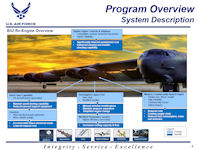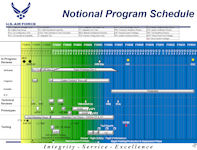B-52 Stratofortress Re-Engine - 2017
The B-52H Commercial Engine Replacement Program (CERP) was to replace the legacy TF33 engines with fuel-efficient, commercial-derivative engines, increases electrical power generation capacity, and integrates digital engine controls and displays. The Air Force was conducting government-led engine source selection process with final engine selection planned for January 2021. Primary engine competitors include General Electric, Rolls Royce, and Pratt & Whitney. Competing contractors were expected to deliver initial aerodynamic models in early FY20.
In late 2017 momentum had increased for an engine replacement in response to the USAF’s B-52H Engine Alternative Study, although the service had yet to establish a program of record or release a request for proposals. The USAF had foregone plans to reconfigure the B-52s with four engines, which would have required expensive modifications to the wing. R-R previously considered a higher thrust variant of the RB211 turbofan engine as a four-engine option on the B-52, but the service was not moving in that direction.
While rival engine manufacturer Pratt & Whitney had touted an upgraded version of its original TF33 engine to sustain the B-52 through 2050, R-R cites support from both Boeing and the USAF for a replacement rather than refurbishment.
Rolls-Royce was pitching the BR725 for the US Air Force’s B-52 bomber re-engine effort. The BR725 combines proven features from the BR 700 and Trent families and as such provides clean, efficient power for a whole new class of business jets. Compared with its highly successful predecessor, the BR710, the BR725 was more powerful, with a maximum thrust of 16,100lb, was more than 4 dB cumulative quieter, has 4 percent better specific fuel consumption and shows 21 percent improvement in NOx emissions. The advanced technology of this engine has significantly increased maintenance intervals, lowering maintenance and lifecycle cost and has eliminated mid-life inspections.
The BR725 combines proven features from the BR 700 and Trent families. The BR725 features a 50 inch diameter titanium swept fan based on world-class Trent fan design for improved aerodynamic efficiency and lower noise – a first time in the business aviation market. The 24 blades are driven by a three-stage, low-pressure turbine, for improved flow, increased efficiency, reduced noise and lower emissions. Ten-stage high-pressure compressor incorporates the latest aerodynamic improvements and five stages of blisks for improved performance and optimized weight. The two-stage shrouded high-pressure turbine uses advanced aerodynamic design and latest material for high efficiency, enhanced performance retention and longer life. A high-efficiency thrust reverser system enables increased reverse thrust and lower drag.
On 19 May 2014 Rolls-Royce announced the BR725 engines will power Gulfstream's new ultra-long-range business jet - the G650ER. The BR725 incorporates technology from the market-leading Trent widebody engine family and was designed with excellent fuel efficiency and ample thrust margins that support the G650ER's enhanced performance. More than 200 BR725 engines have already been built at Rolls-Royce's Dahlewitz site in Germany. The engine was part of the Rolls-Royce BR700 engine family that has accumulated more than 16 million flying hours to date and also comprises the BR710 and BR715.
R-R's 700-series engines are part of the USAF’s F130 engine family, on the Bombardier Global 5000-based E-11A Battlefield Airborne Communications Node aircraft and the Gulfstream G550-based C-37A. If the USAF moved forward with engine replacement by R-R, the company would create a new F130 engine assembly and test line in the US, while production of commercial variant, the BR725, would continue in Germany.
After briefing their acquisition strategy to Dr. William Roper, the U.S. Air Force Service Acquisition Executive, at Milestone B, which included plans for moving to a virtual system prototype to deliver residual operation capability, members of the CERP program found themselves at a red light. Dr. Roper then challenged the group to consider leveraging Section 804 authorities to plan the program with a Middle Tier of Acquisition strategy. Abby Pogorzelski, CERP Program Manager, revealed they had to “develop our strategy from the bottom up.” To add to their already strenuous task, the group had only one night to “ensure we were following the intent of the law.” In the end, all their efforts to save money while also providing new engines for the B-52 paid off. Pogorzelski added that the team learned to “take smart risks,” but did so under the guidelines of Section 804. This victory resulted in schedule and cost reduction, reduction of non-value added documentation, early virtual prototypes and the ability to release RFPs in milestones. The Air Force began the B-52H CERP program in early 2018, and DOT&E placed the program on oversight in February 2018. This was the first time DOT&E had included this program in its annual report. The Air Force formally designated B-52H CERP as a rapid prototyping MTA program in September 2018 leading to acquisition of approximately 650 engines to modify and support the 76-aircraft B-52H fleet. The Air Force implemented a government-led engine source selection strategy coupled with a prime contractor-led integration program. Primary engine competitors include General Electric, Rolls Royce, and Pratt & Whitney with final selection planned in January 2021. Competing contractors are expected to deliver initial aerodynamic models in early FY20.
The Air Force was pursuing a three-part rapid prototyping strategy beginning with development of a Virtual Power Pod Prototype (vPPP) digital model for each candidate engine to assess two engine, side-by-side pod design options. Results from the vPPP models will support development of a Virtual System Prototype (vSP) full aircraft digital model of the selected engine to support a preliminary system design assessment. System-level vSP assessments will be followed by physical modification of two B-52H prototype aircraft to support initial aircraft performance, flying quality, and structural test activities.
The Air Force developed a fleet modification/production strategy for the remaining 74 B-52H aircraft. This strategy includes production of 11 LRIP aircraft to support the final phase of system development testing and IOT&E. The remaining 65 aircraft would be produced in 6 full-rate production lots. The Air Force continues to evaluate options to accelerate production and fielding, including the potential use of the MTA rapid fielding pathway.
The Air Force was progressing toward fulfillment of the NDAA 2020 requirement to submit a B-52 CERP TEMP for DOT&E approval. The TEMP was in final Service coordination with submission for DOT&E approval anticipated in January 2020. This document defines a five-phase integrated test strategy designed to maximize collection of operationally relevant test data during the prototyping phase and a limited operational demonstration of the two prototype aircraft. The TEMP also defines the test requirements and resources necessary to complete an adequate IOT&E using production-representative LRIP aircraft prior to a Full-Rate Production/fleet modification decision. The TEMP will be updated, if required, following approval of the B-52 CERP CDD that will finalize program operational requirements.
The Air Force Operational Test and Evaluation Center (AFOTEC) operational test strategy provides an adaptive framework to support progressive evaluation of system capabilities during prototype development. The AFOTEC operational test design, early data collection strategy, and cumulative reporting approach provides an adequate basis for tailored integration of operational testing with the B-52 rapid prototyping program. Prototype testing will culminate in an AFOTEC operational demonstration to assess residual conventional and nuclear mission capabilities.
The program test strategy also includes a B-52 CERP IOT&E, using LRIP aircraft, following program transition from prototyping to a more traditional final development and production program. IOT&E will leverage all previously collected test data to support a final evaluation of production system operational effectiveness, suitability, and survivability across the full spectrum of nuclear, conventional, and training missions.
|
NEWSLETTER
|
| Join the GlobalSecurity.org mailing list |
|
|
|



